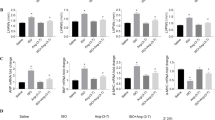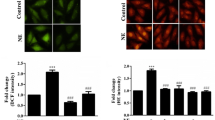Abstract
Atrial natriuretic peptide (ANP)/natriuretic peptide receptor-A (NPR-A) system is suggested as an endogenous anti-hypertrophic protective mechanism of the heart. We have shown previously that Angiotensin II (ANG II), an effector molecule of renin–angiotensin–aldosterone system, down-regulates NPR-A expression and its activity in vivo rat heart. However, the underlying mechanism by which ANG II down-regulates NPR-A expression in the heart is not well understood. Hence, the present investigation was aimed to determine whether ANG II-stimulated reactive oxygen species (ROS) and NF-κB are involved in the down-regulation of NPR-A activity in H9c2 (2-1) cardiac myoblast cells. The H9c2 (2-1) cardiac myoblast cells were exposed to ANG II (10−7 M for 20 h) with/or without blocker treatment (losartan-10 µM, N-acetyl cysteine (NAC)-10 mM and pyrrolidine dithiocarbamate (PDTC)-100 µM). On exposure, ANG II induced a significant decrease (P < 0.001) in the expression of Npr1 (coding for NPR-A) gene and NPR-A receptor-dependent guanylyl cyclase (GC) activity. The level of expression of proto-oncogenes (c-fos, c-myc, and c-jun) and natriuretic peptides (ANP and BNP) was increased in ANG II-treated cells when compared with control cells. Interestingly, ANG II-dependent repression of Npr1 gene expression and guanylyl cyclase (GC) activity was completely restored on treatment with losartan, while only a partial reversal was observed in NAC- and PDTC-co-treated cells. In conclusion, the results of this study suggest that ROS-mediated NF-κB activation mechanism is critically involved in the ANG II-mediated down-regulation of NPR-A expression and its GC activity.





Similar content being viewed by others

References
de Bold AJ (1985) Atrial natriuretic factor: a hormone produced by the heart. Science 230:767–770
Levin ER, Gardner DG, Samson WK (1998) Natriuretic peptides. N Engl J Med 339:321–328
Drewett JG, Garbers DL (1994) The family of guanylyl cyclase receptors and their ligands. Endocr Rev 15:135–162
Oliver PM, Fox JE, Kim R, Rockman HA, Kim HS, Reddick RL, Pandey KN, Milgram SL, Smithies O, Maeda N (1997) Hypertension, cardiac hypertrophy, and sudden death in mice lacking natriuretic peptide receptor A. Proc Natl Acad Sci USA 94:14730–14735
Knowles JW, Esposito G, Mao L, Hagaman JR, Fox JE, Smithies O, Rockman HA, Maeda N (2001) Pressure-independent enhancement of cardiac hypertrophy in natriuretic peptide receptor A-deficient mice. J Clin Invest 107:975–984
Kishimoto I, Rossi K, Garbers DL (2001) A genetic model provides evidence that the receptor for atrial natriuretic peptide (guanylyl cyclase-A) inhibits cardiac ventricular myocyte hypertrophy. Proc Natl Acad Sci USA 98:2703–2706
Zahabi A, Picard S, Fortin N, Reudelhuber TL, Deschepper CF (2003) Expression of constitutively active guanylate cyclase in cardiomyocytes inhibits the hypertrophic effects of isoproterenol and aortic constriction on mouse hearts. J Biol Chem 278:47694–47699
Holtwick R, van Eickels M, Skryabin BV, Baba HA, Bubikat A, Begrow F, Schneider MD, Garbers DL, Kuhn M (2003) Pressure-independent cardiac hypertrophy in mice with cardiomyocyte-restricted inactivation of the atrial natriuretic peptide receptor guanylyl cyclase-A. J Clin Invest 111:1399–1407
Ellmers LJ, Scott NJ, Piuhola J, Maeda N, Smithies O, Frampton CM, Richards AM, Cameron VA (2007) Npr1-regulated gene pathways contributing to cardiac hypertrophy and fibrosis. J Mol Endocrinol 38(1–2):245–257
Kishimoto I, Tokudome T, Horio T, Garbers DL, Nakao K, Kangawa K (2009) Natriuretic peptide signaling via guanylyl cyclase (GC)-A: an endogenous protective mechanism of the heart. Curr Cardiol Rev 5:45–51
Yoshimura M, Yasue H, Okumura K, Ogawa H, Jougasaki M, Mukoyama M, Nakao K, Imura H (1993) Different secretion patterns of atrial natriuretic peptide and brain natriuretic peptide in patients with congestive heart failure. Circulation 87:464–469
Ghosh N, Haddad H (2011) Atrial natriuretic peptides in heart failure: pathophysiological significance, diagnostic and prognostic value. Can J Physiol Pharmacol 89:587–591
Lu Y, Yang S (2009) Angiotensin II induces cardiomyocyte hypertrophy probably through histone deacetylases. Tohoku J Exp Med 219:17–23
Zhou D, Liang Q, He X, Zhan C (2008) Changes of c-fos and c-jun mRNA expression in angiotensin II-induced cardiomyocyte hypertrophy and effects of sodium tanshinone IIA sulfonate. J Huazhong Univ Sci Technol Med Sci 28:531–534
Touyz RM, Schiffrin EL (2000) Signal transduction mechanisms mediating the physiological and pathophysiological actions of angiotensin II in vascular smooth muscle cells. Pharmacol Rev 52:639–672
Griendling KK, Sorescu D, Ushio-Fukai M (2000) NAD(P)H oxidase: role in cardiovascular biology and disease. Circ Res 86:494–501
Papparella I, Ceolotto G, Montemurro D, Antonello M, Garbisa S, Rossi G, Semplicini A (2008) Green tea attenuates angiotensin II-induced cardiac hypertrophy in rats by modulating reactive oxygen species production and the Src/epidermal growth factor receptor/Akt signaling pathway. J Nutr 138:1596–1601
Dhiman M, Garg NJ (2011) NADPH oxidase inhibition ameliorates Trypanosoma cruzi-induced myocarditis during Chagas disease. J Pathol 225:583–596
Wattanapitayakul SK, Bauer JA (2001) Oxidative pathways in cardiovascular disease: roles, mechanisms, and therapeutic implications. Pharmacol Ther 89:187–206
Freund C, Schmidt-Ullrich R, Baurand A, Dunger S, Schneider W, Loser P, El-Jamali A, Dietz R, Scheidereit C, Bergmann MW (2005) Requirement of nuclear factor-kappaB in angiotensin II- and isoproterenol-induced cardiac hypertrophy in vivo. Circulation 111:2319–2325
Gupta S, Purcell NH, Lin A, Sen S (2002) Activation of nuclear factor-kappaB is necessary for myotrophin-induced cardiac hypertrophy. J Cell Biol 159:1019–1028
Zou XJ, Yang L, Yao SL (2008) Propofol depresses angiotensin II-induced cardiomyocyte hypertrophy in vitro. Exp Biol Med (Maywood) 233:200–208
Ryan KA, Smith MF Jr, Sanders MK, Ernst PB (2004) Reactive oxygen and nitrogen species differentially regulate Toll-like receptor 4-mediated activation of NF-kappa B and interleukin-8 expression. Infect Immun 72:2123–2130
Zhang L, Pang S, Deng B, Qian L, Chen J, Zou J, Zheng J, Yang L, Zhang C, Chen X, Liu Z, Le Y (2012) High glucose induces renal mesangial cell proliferation and fibronectin expression through JNK/NF-κB/NADPH oxidase/ROS pathway, which is inhibited by resveratrol. Int J Biochem Cell Biol 44:629–638
Gopi V, Parthasarathy A, Umadevi S, Vellaichamy E (2013) Angiotensin-II down-regulates cardiac natriuretic peptide receptor-A mediated anti-hypertrophic signaling in experimental rat hearts. Indian J Exp Biol 51:48–55
Gauquelin G, Schiffrin EL, Garcia R (1991) Downregulation of glomerular and vascular atrial natriuretic factor receptor subtypes by angiotensin II. J Hypertens 9:1151–1160
Arise KK, Pandey KN (2006) Inhibition and down-regulation of gene transcription and guanylyl cyclase activity of NPRA by angiotensin II involving protein kinase C. Biochem Biophys Res Commun 349:131–135
Prathapan A, Vineetha VP, Abhilash PA, Raghu KG (2013) Boerhaavia diffusa L. attenuates angiotensin II-induced hypertrophy in H9c2 cardiac myoblast cells via modulating oxidative stress and down-regulating NF-κβ and transforming growth factor β1. Br J Nutr 110:1201–1210
Flores-Muñoz M, Smith NJ, Haggerty C, Milligan G, Nicklin SA (2011) Angiotensin1-9 antagonises pro-hypertrophic signalling in cardiomyocytes via the angiotensin type 2 receptor. J Physiol 589:939–951
Nakagami H, Takemoto M, Liao JK (2003) NADPH oxidase-derived superoxide anion mediates angiotensin II-induced cardiac hypertrophy. J Mol Cell Cardiol 35:851–859
Tian J, Guo X, Liu XM, Liu L, Weng QF, Dong SJ, Knowlton AA, Yuan WJ, Lin L (2013) Extracellular HSP60 induces inflammation through activating and up-regulating TLRs in cardiomyocytes. Cardiovasc Res 98:391–401
Qin F, Patel R, Yan C, Liu W (2006) NADPH oxidase is involved in angiotensin II-induced apoptosis in H9c2 cardiac muscle cells: effects of apocynin. Free Radic Biol Med 40:236–246
Liao W, Xiao Q, Tchikov V, Fujita KI, Yang W, Wincovitch S, Srinivasula SM (2008) CARP-2 is an endosome-associated ubiquitin ligase for RIP and regulates TNF-induced NF-κB activation. Curr Biol 18:641–649
Garg R, Pandey KN (2003) Angiotensin II-mediated negative regulation of Npr1 promoter activity and gene transcription. Hypertension 41:730–736
Crowley SD, Gurley SB, Herrera MJ, Ruiz P, Griffiths R, Kumar AP, Kim HS, Smithies O, Le TH, Coffman TM (2006) Angiotensin II causes hypertension and cardiac hypertrophy through its receptors in the kidney. Proc Natl Acad Sci USA 103:17985–17990
Yao FR, Sun CW, Chang SK (2010) Morton lentil extract attenuated angiotensin II-induced cardiomyocyte hypertrophy via inhibition of intracellular reactive oxygen species levels in vitro. J Agric Food Chem 58:10382–10388
Gul R, Shawl AI, Kim SH, Kim UH (2012) Cooperative interaction between reactive oxygen species and Ca2+ signals contributes to angiotensin II-induced hypertrophy in adult rat cardiomyocytes. Am J Physiol Heart Circ Physiol 302:H901–H909
Hu TP, Xu FP, Li YJ, Luo JD (2006) Simvastatin inhibits leptin-induced hypertrophy in cultured neonatal rat cardiomyocytes. Acta Pharmacol Sin 27:419–422
Liu J, Zhou J, An W, Lin Y, Yang Y, Zang W (2010) Apocynin attenuates pressure overload-induced cardiac hypertrophy in rats by reducing levels of reactive oxygen species. Can J Physiol Pharmacol 88:745–752
Shih NL, Cheng TH, Loh SH, Cheng PY, Wang DL, Chen YS, Liu SH, Liew CC, Chen JJ (2001) Reactive oxygen species modulate angiotensin II-induced beta-myosin heavy chain gene expression via Ras/Raf/extracellular signal-regulated kinase pathway in neonatal rat cardiomyocytes. Biochem Biophys Res Commun 283:143–148
Mizuno K, Tani M, Hashimoto S, Niimura S, Sanada H, Watanabe H et al (1992) Effects of losartan, a nonpeptide angiotensin II receptor antagonist, on cardiac hypertrophy and the tissue angiotensin II content in spontaneously hypertensive rats. Life Sci 51:367–374
Asehnoune K, Strassheim D, Mitra S, Kim JY, Abraham E (2004) Involvement of reactive oxygen species in Toll-like receptor 4-dependent activation of NF-kappa B. J Immunol 172:2522–2529
Essick EE, Ouchi N, Wilson RM, Ohashi K, Ghobrial J, Shibata R, Pimentel DR, Sam F (2011) Adiponectin mediates cardioprotection in oxidative stress-induced cardiac myocyte remodeling. Am J Physiol Heart Circ Physiol 301:H984–H993
Bottari SP, King IN, Reichlin S, Dahlstroem I, Lydon N, de Gasparo M (1992) The angiotensin AT2 receptor stimulates protein tyrosine phosphatase activity and mediates inhibition of particulate guanylate cyclase. Biochem Biophys Res Commun 183:206–211
Li Y, Ha T, Gao X, Kelley J, Williams DL, Browder IW, Li C (2004) NF-κB activation is required for the development of cardiac hypertrophy in vivo. Am J Physiol Heart Circ Physiol 287:H1712–H1720
Gupta S, Young D, Sen S (2005) Inhibition of NF-κB induces regression of cardiac hypertrophy, independent of blood pressure control, in spontaneously hypertensive rats. Am J Physiol Heart Circ Physiol 289:H20–H29
Haneda M, Kikkawa R, Maeda S, Togawa M, Koya D, Horide N, Kajiwara N, Shigeta Y (1991) Dual mechanism of angiotensin II inhibits ANP-induced mesangial cGMP accumulation. Kidney Int 40:188–194
Izumo S, Nadal Ginard B, Mahdavi V (1988) Protooncogene induction and reprogramming of cardiac gene expression produced by pressure overload. Proc Natl Acad Sci 85:339–343
Komuro I, Kaida T, Shibazaki Y, Kurabayashi M, Katoh Y, Hoh E, Yazaki Y (1990) Stretching cardiac myocytes stimulates protooncogene expression. J Biol Chem 265:3595–3598
Sadoshima J, Izumo S (1993) Signal transduction pathways of angiotensin II–induced c-fos gene expression in cardiac myocytes in vitro: roles of phospholipidderived second messengers. Circ Res 73:424–438
Allen IS, Cohen N, Dhallan R, Gaa ST, Lederer WJ, Rogers TB (1988) Angiotensin II increases spontaneous contractile frequency and stimulates calcium current in cultured neonatal rat heart myocytes: insights into underlying biochemical mechanisms. Circ Res 62:524–534
Sumners C, Myers LM (1991) Angiotensin II decreases cGMP levels in neuronal cultures from rat brain. Am J Physiol 260:C79–C87
Joubert S, Labrecque J, De Léan A (2001) Reduced activity of the NPR-A kinase triggers dephosphorylation and homologous desensitization of the receptor. Biochemistry 40:11096–11105
Acknowledgments
This work was carried out by the research grants sanctioned to Dr.EV from UGC and CSIR New Delhi, India, and are greatly acknowledged.
Author information
Authors and Affiliations
Corresponding author
Rights and permissions
About this article
Cite this article
Gopi, V., Subramanian, V., Manivasagam, S. et al. Angiotensin II down-regulates natriuretic peptide receptor-A expression and guanylyl cyclase activity in H9c2 (2-1) cardiac myoblast cells: Role of ROS and NF-κB. Mol Cell Biochem 409, 67–79 (2015). https://doi.org/10.1007/s11010-015-2513-0
Received:
Accepted:
Published:
Issue Date:
DOI: https://doi.org/10.1007/s11010-015-2513-0



